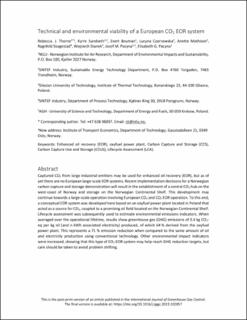| dc.contributor.author | Thorne, Rebecca Jayne | |
| dc.contributor.author | Sundseth, Kyrre | |
| dc.contributor.author | Bouman, Evert | |
| dc.contributor.author | Czarnowska, Lucyna | |
| dc.contributor.author | Mathisen, Anette | |
| dc.contributor.author | Skagestad, Ragnhild | |
| dc.contributor.author | Stanek, Wojciech | |
| dc.contributor.author | Pacyna, Jozef M | |
| dc.contributor.author | Pacyna, Elisabeth G | |
| dc.date.accessioned | 2020-11-19T10:29:06Z | |
| dc.date.available | 2020-11-19T10:29:06Z | |
| dc.date.created | 2019-11-11T12:42:20Z | |
| dc.date.issued | 2019 | |
| dc.identifier.issn | 1750-5836 | |
| dc.identifier.uri | https://hdl.handle.net/11250/2688640 | |
| dc.description.abstract | Captured CO2 from large industrial emitters may be used for enhanced oil recovery (EOR), but as of yet there are no European large-scale EOR systems. Recent implementation decisions for a Norwegian carbon capture and storage demonstration will result in the establishment of a central CO2 hub on the west-coast of Norway and storage on the Norwegian Continental Shelf. This development may continue towards a large-scale operation involving European CO2 and CO2 EOR operation. To this end, a conceptual EOR system was developed here based on an oxyfuel power plant located in Poland that acted as a source for CO2, coupled to a promising oil field located on the Norwegian Continental Shelf. Lifecycle assessment was subsequently used to estimate environmental emissions indicators. When averaged over the operational lifetime, results show greenhouse gas (GHG) emissions of 0.4 kg CO2-eq per kg oil (and n kWh associated electricity) produced, of which 64 % derived from the oxyfuel power plant. This represents a 71 % emission reduction when compared to the same amount of oil and electricity production using conventional technology. Other environmental impact indicators were increased, showing that this type of CO2 EOR system may help reach GHG reduction targets, but care should be taken to avoid problem shifting. | en_US |
| dc.language.iso | eng | en_US |
| dc.publisher | Elsevier | en_US |
| dc.rights | Attribution-NonCommercial-NoDerivatives 4.0 Internasjonal | * |
| dc.rights.uri | http://creativecommons.org/licenses/by-nc-nd/4.0/deed.no | * |
| dc.subject | Lifecycle assessment (LCA) | en_US |
| dc.subject | Carbon capture use and storage (CCUS) | en_US |
| dc.subject | Carbon capture and storage (CCS) | en_US |
| dc.subject | Oxyfuel power plant | en_US |
| dc.subject | Enhanced oil recovery (EOR) | en_US |
| dc.title | Technical and environmental viability of a European CO2 EOR system | en_US |
| dc.type | Peer reviewed | en_US |
| dc.type | Journal article | en_US |
| dc.description.version | acceptedVersion | en_US |
| dc.rights.holder | © 2019 Published by Elsevier Ltd | en_US |
| dc.source.pagenumber | 14 | en_US |
| dc.source.volume | 92 | en_US |
| dc.source.journal | International Journal of Greenhouse Gas Control | en_US |
| dc.identifier.doi | 10.1016/j.ijggc.2019.102857 | |
| dc.identifier.cristin | 1745979 | |
| dc.relation.project | NILU - Norsk institutt for luftforskning: 114038 | en_US |
| dc.relation.project | EØS - Det europeiske økonomiske samarbeidsområde: 234830 | en_US |
| dc.source.articlenumber | 102857 | en_US |
| cristin.unitcode | 7401,80,62,0 | |
| cristin.unitcode | 7401,80,40,0 | |
| cristin.unitname | Bærekraftig energiteknologi | |
| cristin.unitname | Prosessteknologi | |
| cristin.ispublished | true | |
| cristin.fulltext | original | |
| cristin.fulltext | postprint | |
| cristin.qualitycode | 2 | |

